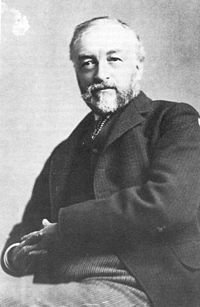Samuel Pierpont Langley
Samuel Pierpont Langley (born August 22, 1834 in Roxbury , Massachusetts , † February 27, 1906 in Aiken , South Carolina ) was an American astrophysicist and aviation pioneer . Langley invented the bolometer , among other things .
Life
astronomy
Langley was between 1866 and 1887 professor of physics and astronomy at the Western University of Pennsylvania and from 1867 director of the Allegheny Observatory . Here he examined the infrared component of solar radiation in the solar spectrum . From 1887 he was director ( Secretary ) of the Smithsonian Institution in Washington, DC In 1890 he founded the Smithsonian Astrophysical Observatory .
Aircraft heavier than air

Langley is one of the pioneers in aerodynamics . He contributed significantly to the theory and development of the first airworthy objects heavier than air and constructed one of the first machine-powered aircraft that was unmanned and launched with the help of a catapult . On May 6, 1896, his unmanned Aërodrome No. 5 approximately 1,200 meters after a catapult launch from a boat in the Potomac River . In 1895 he undertook a trip to Europe, which also took him to Berlin to see Otto Lilienthal , and for aerodynamic experiments he hired Augustus Herring , who went back to Octave Chanute in January 1896 .
With the manned development of his aircraft called The Great Aerodrome , Langley had his assistant, Charles Matthews Manly , fly in 1903 . However, the attempt on October 7, 1903 failed miserably, after a few meters the pilot picked his nose into the water, and the pilot was able to save himself effortlessly (in a later attempt in December 1903, however, he was briefly trapped under water).
Replicas of Langley's flying machines built with today's knowledge and equipped with modern machines were successfully flown and thus proved the potential of Langley's constructions.
Samuel Pierpont Langley died on February 27, 1906 in Aiken, South Carolina.
Honors
In 1876 Langley was elected to the National Academy of Sciences , in 1883 to the American Academy of Arts and Sciences . He received the Rumford Medal in 1886 and the Jules Janssen Prize in 1898 . An air force base of the US Air Force , Langley Air Force Base , the two aircraft carriers USS Langley (CV-1) and USS Langley (CVL-27) and the Langley Research Center , the Langley unit of measurement , is named after him Solar radiation on the earth's surface is given, as well as the lunar crater Langley , the asteroid (3866) Langley and the Langley Peak in Antarctica.
In 1888 he became a corresponding member of the Académie des sciences . In 1895 he was admitted to the Royal Society as a Foreign Member . In 1902 he became an Honorary Fellow of the Royal Society of Edinburgh .
Web links
- Publications by SP Langley in the Astrophysics Data System
- CG Abbott: Samuel Pierpont Langley. Astrophysical Journal , vol. 23 (1906), p. 271 (obituary, English)
- JA Brashear: Samuel Pierpont Langley . Popular Astronomy, vol. 14 (1906), pp. 257–264 (obituary, English)
- RC: Obituary notice of Langley, SP Monthly Notices of the Royal Astronomical Society, vol. 67 (1907), p. 239 (obituary, English)
Individual evidence
- ^ C. David Gierke: Langley's Steam-powered Flying Machines . In: Aviation History . 8, No. 6, p. 50.
- ^ Members of the American Academy. Listed by election year, 1850–1899 ( PDF ). Retrieved September 24, 2015
- ^ List of members since 1666: Letter L. Académie des sciences, accessed on January 8, 2020 (French).
- ^ Entry on Langley, Samuel Pierpont (1834-1906) in the Archives of the Royal Society , London
- ^ Fellows Directory. Biographical Index: Former RSE Fellows 1783–2002. (PDF file) Royal Society of Edinburgh, accessed December 29, 2019 .
| personal data | |
|---|---|
| SURNAME | Langley, Samuel Pierpont |
| BRIEF DESCRIPTION | American astrophysicist and aviation pioneer |
| DATE OF BIRTH | August 22, 1834 |
| PLACE OF BIRTH | Roxbury , Massachusetts |
| DATE OF DEATH | February 27, 1906 |
| Place of death | Aiken , South Carolina |


